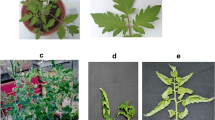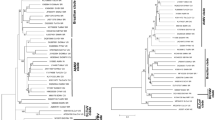Abstract
Okra or bhendi (Abelmoschus esculentus) is one of the most popular and widely grown vegetable crops in India. Whitefly (Bemisia tabaci) transmitted begomoviruses cause heavy economic loss in the okra cultivation in India. In the present study, full length annotated DNA-A (~ 2.7 kb) sequences of 134 begomoviruses infecting okra in India available in NCBI database were retrieved, analyzed and compared following with other begomovirus sequences. The sequence analysis reveals extensive genetic diversity among the begomoviruses infecting okra in India showing 69–100% nt identity among them. The present phylogenetic analysis displays an extensive genetic diversity among begomoviruses infecting okra in India showing occurrence of at least 14 Types begomoviruses. Majority of the present sequences fell into two major Types; 45 sequences into Type-5 i.e., Bhendi yellow vein mosaic virus (BYVMV-[IN-Mah-NOL751]EU589392) strain and 44 sequences into Type-9 i.e., BYVMV-Har[IN-Har-07]FN645923 and/or BYVMV-IN[IN-Mad]AF241479 strain. Five Indian sequences fell into Type-7 i.e., BYVMV-TN[IN-Coi4-04]FJ179372 and/or BYVMV-[PK-Fai201-95]AJ002451 strain and eight sequences into Type 1 i.e., Okra enation leaf curl virus (OELCuV,GU111996). Four sequences in Type-13 i.e., Tomato leaf curl New Delhi (ToLCNDV), three in Type-6 i.e., Cotton leaf curl Alabad (CLCuAlV), two in Type 14 i.e., Bhendi yellow vein mosaic Bhubaneswar (BYVBhV) and three in Type-2 i.e., Mesta yellow vein mosaic virus (MeYVMV). The other sequences were distributed into another six distinct types or putative species. Recombination analysis showed that most of the present begomovirus types identified were recombinants. The present study reports that DNA-A sequences of begomovirus infecting okra in India are extensively diverse and originated from recombination events involving diverse begomovirus sequences.


Similar content being viewed by others
References
Anonymous (2017) Horticultural Statistics at a Glance 2017. Horticulture Statistics Division, Department of Agriculture, Cooperation & Farmers Welfare, Ministry of Agriculture & Farmers welfare, Government of India. https://www.agricoop.nic.in
Brown JK (2007) The Bemisia tabaci complex: genetic and phenotypic variability drives begomovirus spread and virus diversification. https://doi.org/10.1094/APSnetFeature/2007-0107
Brown JK, Zerbini FM, Navas-Castillo J, Moriones E, Ramos-Sobrinho R, Silva JCF, Fiallo-Olive E, Briddon RW, Hernandez-Zepeda C, Idris A, Malathi VG, Martin DP, Rivera-Bustamante R, Ueda S, Varsani A (2015) Revision of Begomovirus taxonomy based on pairwise sequence comparisons. Arch Virol 160:1593–1619
Gill RJ, Brown JK (2010) Systematics of bemisia and bemisia relatives: can molecular techniques solve the bemisia tabaci complex conundrum-a taxonomist's viewpoint. In: Stansly P, Naranjo S (eds) Bemisia: bionomics and management of a global pest. Springer, Netherlands, pp 5–29
Godara S, Paul Khurana SM, Biswas KK (2016) Three variants of cotton leaf curl begomoviruses with theirsatellite molecules are associated with cotton leaf curl disease aggravation in New Delhi. J Plant Biochem Biotechnol 26:97–105
Hall TA (1999) BioEdit: a user-friendly biological sequence alignment editor and analysis program for Windows 95/98/NT. Nucleic Acids Symp Ser 41:95–98
Jose J, Usha R (2003) Bhendi yellow vein mosaic disease in India is caused by association of a DNA Beta satellite with a begomovirus. Virology 305:310–317
Kulkarni CS (1924) Mosaic and other related diseases of crops in the Bombay Presidency. Poona Agriculture College Magazine, Pune, p 16
Kumar RV, Prasanna HC, Singh AK, Ragunathan D, Garg GK, Chakraborty S (2016) Molecular genetic analysis and evolution of begomoviruses and betasatellites causing yellow mosaic disease of bhendi. Virus Genes. https://doi.org/10.1007/s11262-016-1414-y
Lefeuvre P, Moriones E (2015) Recombination as a motor of host switches and virus emergence: geminiviruses as case studies. Curr Opin Virol 10:14–19
Martin DP, Murrell B, Golden M, Khoosal A, Muhire B (2015) RDP4: detection and analysis of recombination patterns in virus genomes. Virus Evol 1:vev003. https://doi.org/10.1093/ve/vev003
Padidam M, Sawyer S, Fauquet CM (1999) Possible emergence ofnew geminiviruses by frequent recombination. Virology 265:218–225
Setty AA, Singh JP, Singh D (2013) Resistance to yellow vein mosaic virus in okra: a review. Biol Agric Hortic 29:159–164
Singh SJ (1996) Assessment of losses in okra due to enation leaf curl virus. Indian J Virol 12:51–53
Tamura K, Stecher G, Peterson D, Filipski A, Kumar S (2013) MEGA6: molecular evolutionary genetics analysis Version 6.0. Mol Biol Evol 30:2725–2729
Thompson JD, Gibson TJ, Plewniak F, Jeanmougin F, Higgins DG (1997) The CLUSTAL-X windows interface: flexible strategies for multiple sequence alignment aided by quality analysis tools. Nucleic Acid Res 24:4876–4882
Venkataravanappa V, Reddy LCN, Jalali S, Reddy MK (2012) Molecular characterization of distinct bipartite begomovirus infecting bhendi (Abelmoschus esculentus L.). Virus Genes 44:522–535
Venkataravanappa V, Prasanna HC, Reddy CNL, Reddy MK (2014) Evidence for two predominant viral lineages, recombination and subpopulation structure in begomoviruses associated with yellow vein mosaic disease of okra in India. Plant Pathol 64:508–518
Acknowledgements
The authors are thankful to R. Aggarwal, Head; V. K. Baranwal, In-charge, Plant Virology Unit; Division of Plant Pathology; Director, ICAR-IARI, New Delhi for providing the facility.
Author information
Authors and Affiliations
Corresponding author
Rights and permissions
About this article
Cite this article
Biswas, K.K., Palchoudhury, S., Shukla, P. et al. DNA-A sequences of whitefly transmitted begomovirus infecting okra (Abelmoschus esculentus) in India are extensively diverse. Indian Phytopathology 71, 249–256 (2018). https://doi.org/10.1007/s42360-018-0042-y
Received:
Accepted:
Published:
Issue Date:
DOI: https://doi.org/10.1007/s42360-018-0042-y




